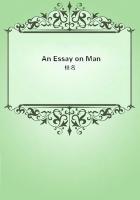The Osmia's repugnance to big cylinders is quite justified. The work in fact is longer and more costly when the tubes are wide. An inspection of a nest constructed under these conditions is enough to convince us. It now consists not of a string of chambers obtained by ****** transverse partitions, but of a confused heap of clumsy, many-sided compartments, standing back to back, with a tendency to group themselves in storeys without succeeding in doing so, because any regular arrangement would mean that the ceilings possessed a span which it is not in the builder's power to achieve. The edifice is not a geometrical masterpiece and it is even less satisfactory from the point of view of economy. In the previous constructions, the sides of the reed supplied the greater part of the walls and the work was limited to one partition for each cell. Here, except at the actual periphery, where the tube itself supplies a foundation, everything has to be obtained by sheer building: the floor, the ceiling, the walls of the many-sided compartment are one and all made of mortar.
The structure is almost as costly in materials as that of the Chalicodoma or the Pelopaeus.
It must be pretty difficult, too, when one thinks of its irregularity. Fitting as best she can the projecting angles of the new cell into the recessed corners of the cell already built, the Osmia runs up walls more or less curved, upright or slanting, which intersect one another at various points, so that each compartment requires a new and complicated plan of construction, which is very different from the circular-partition style of architecture, with its row of parallel dividing-disks. Moreover, in this composite arrangement, the size of the recesses left available by the earlier work to some extent decides the assessment of the ***es, for, according to the dimensions of those recesses, the walls erected take in now a larger space, the home of a female, and now a smaller space, the home of a male. Roomy quarters therefore have a double drawback for the Osmia: they greatly increase the outlay in materials; and also they establish in the lower layers, among the females, males who, because of their earlier hatching, would be much better placed near the mouth of the nest. I am convinced of it: if the Osmia refuses big reeds and accepts them only in the last resort, when there are no others, it is because she objects to additional labour and to the mixture of the ***es.
The Snail-shell, then, is but an indifferent home for her, which she is quite ready to abandon should a better offer. Its expanding cavity represents an average between the favourite small cylinder and the unpopular large cylinder, which is accepted only when there is no other obtainable. The first whorls of the spiral are too narrow to be of use to the Osmia, but the middle ones have the right diameter for cocoons arranged in single file. Here things happen as in a first-class reed, for the helical curve in no way affects the method of structure employed for a rectilinear series of cells. Circular partitions are erected at the required distances, with or without a serving-hatch, according to the diameter. These mark out the first cells, one after the other, which are reserved solely for the females. Then comes the last whorl, which is much too wide for a single row of cells; and here we once more find, exactly as in a wide reed, a costly profusion of masonry, an irregular arrangement of the cells and a mixture of the ***es.
Having said so much, let us go back to the Osmia of the quarries.
Why, when I offer them simultaneously Snail-shells and reeds of a suitable size, do the old frequenters of the shells prefer the reeds, which in all probability have never before been utilized by their race? Most of them scorn the ancestral dwelling and enthusiastically accept my reeds. Some, it is true, take up their quarters in the Snail-shell; but even among these a goodly number refuse my new shells and return to their birth-place, the old Snail-shell, in order to utilize the family property, without much labour, at the cost of a few repairs. Whence, I ask, comes this general preference for the cylinder, never used hitherto? The answer can be only this: of two lodgings at her disposal the Osmia selects the one that provides a comfortable home at a minimum outlay. She economizes her strength when restoring an old nest; she economizes it when replacing the Snail-shell by the reed.
Can animal industry, like our own, obey the law of economy, the sovran law that governs our industrial machine even as it governs, at least to all appearances, the sublime machine of the universe? Let us go deeper into the question and bring other workers into evidence, those especially who, better equipped perhaps and at any rate better fitted for hard work, attack the difficulties of their trade boldly and look down upon alien establishments with scorn. Of this number are the Chalicodomae, the Mason-bees proper.
The Mason-bee of the Pebbles does not make up her mind to build a brand-new dome unless there be a dearth of old and not quite dilapidated nests. The mothers, sisters apparently and heirs-at-law to the domain, dispute fiercely for the ancestral abode. The first who, by sheer brute force, takes possession of the dome, perches upon it and, for long hours, watches events while polishing her wings. If some claimant puts in an appearance, forthwith the other turns her out with a volley of blows. In this way the old nests are employed so long as they have not become uninhabitable hovels.
Without being equally jealous of the maternal inheritance, the Mason-bee of the Sheds eagerly uses the cells whence her generation issued.















